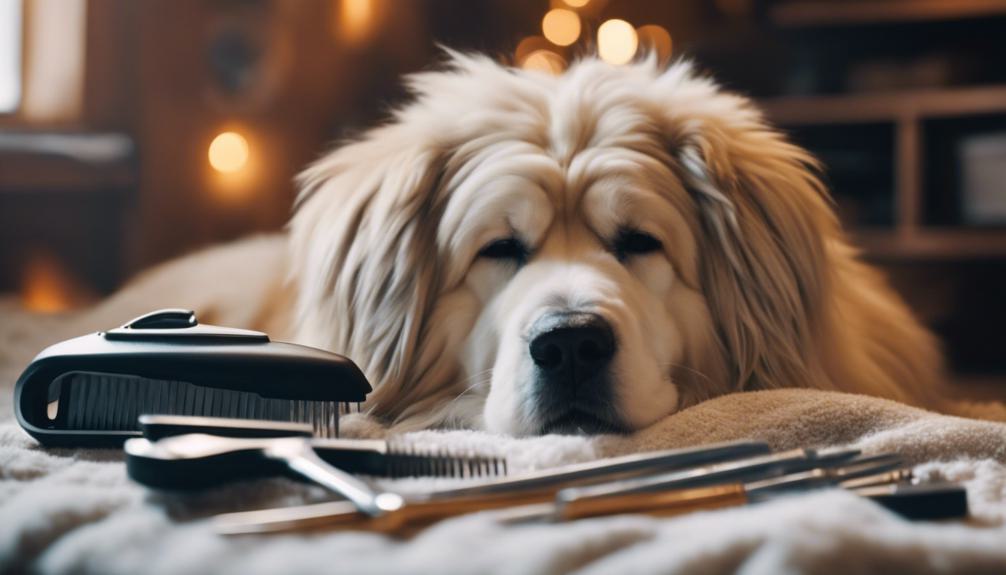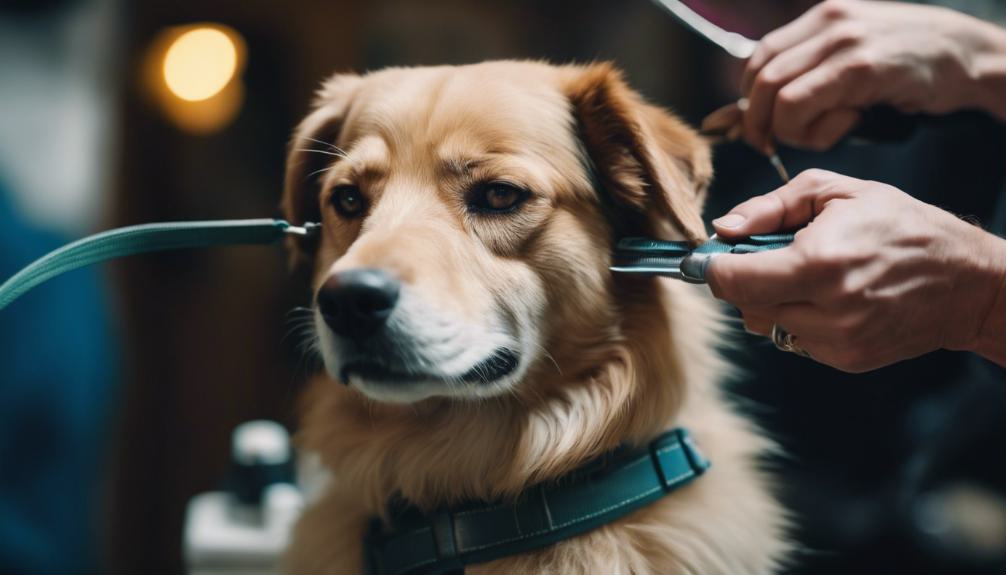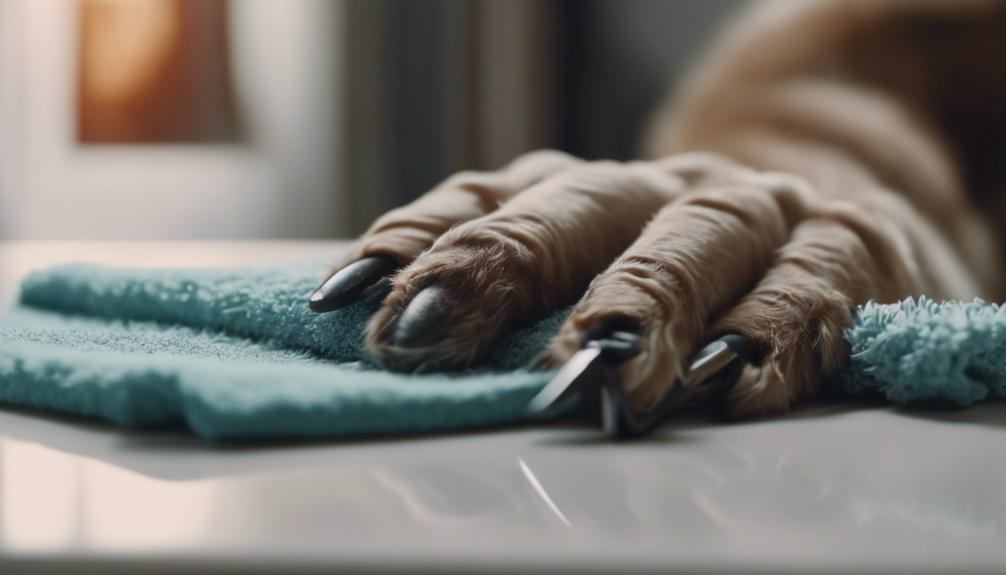How to Trim a Skittish Dog’s Nails? Gentle Approach
To grasp your skittish dog’s nails, initiate by establishing a calming environment. Utilize treats and gradual training. Observe body language like lip licking or tail tucked. Acquaint nail clippers slowly and reward calm behavior. Ensure your dog connects nail trimming with positive experiences. Employ gentle restraint techniques and reassure your dog throughout. Remember, interpreting your dog’s body language is key to success.
Understanding Your Dog’s Body Language
Knowing how to read your dog’s body language is key when trimming their nails. Many dogs feel scared during nail trims because the sensations and noises are new to them. To reduce their fear, train your dog slowly using treats and praise.
Look for stress signals such as lip licking or yawning, which show discomfort. Notice if your dog’s tail is tucked, their body is stiff, or their ears are pinned back, as these are signs they’re not relaxed. If your dog trembles or growls, stop the trimming, and comfort them before continuing.
Setting Up a Calm Environment
To set up a calm environment for trimming your skittish dog’s nails, choose a quiet, familiar room with few distractions. Place a yoga mat or towel on the floor to prevent your dog from slipping. This makes your dog feel more secure. Keep your voice low and soothing to help calm your dog and reduce its anxiety. You might also use pheromone sprays or play calming music to help relax your dog during the nail trimming session. Make sure the room is well-lit so you can see your dog’s nails clearly and avoid cutting the quick. By preparing a tranquil setting, you make the nail trimming process easier for both you and your dog.
| Key Element | Description |
|---|---|
| Trimming | Trim your dog’s nails in a calm setting. |
| Calm Demeanor | Keep a soothing and composed attitude while trimming your dog’s nails. |
| Non-Slip Surface | Use items like a yoga mat to prevent your dog from slipping. |
| Proper Lighting | Good lighting is crucial to see your dog’s nails clearly for safe trimming. |
This setup helps ensure a stress-free experience for your dog, making the nail trimming session smoother for both of you.
Desensitizing Your Dog to Nail Trimming Tools

Present the nail clippers to your nervous dog from a safe distance. Allow your dog to sniff and explore the clippers without any pressure to trim.
Gradually introduce the sound of the clippers by clicking them nearby, without making contact with their nails. Reward your dog with treats and praise when they remain calm near the clippers.
Consistently repeat these steps to help your dog become accustomed to the nail trimming tools. By linking the clippers with positive experiences, your dog will start to feel more relaxed and less anxious during nail trimming.
Patience and consistency are crucial in aiding your dog to overcome their fear.
Establishing Positive Associations With Nail Trimming
Create a positive link between nail trimming and rewards to help your skittish dog. Offer your dog treats and praise while gently touching their paws, making them comfortable with the sensation.
Slowly introduce the sound of the clippers to help them get used to it. During nail trimming, reward your dog for staying calm to strengthen positive connections with the activity.
Remain patient and avoid rushing; take breaks if necessary to maintain a positive experience for your dog.
Using Gentle Restraint Techniques

To handle a skittish dog during nail trimming, keep a gentle yet firm hold on their paw to avoid any sudden movements. Here are some effective restraint techniques to consider for a successful nail trimming session:
Wrap your dog in a towel or use a calming pressure wrap to provide a sense of security.
Place your dog on a non-slip surface or have someone help hold your dog steady.
Avoid using overly tight restraints, as these can increase stress.
Be patient and continuously reassure your dog throughout the trimming process.
Maintain a calm and gentle demeanor to successfully trim your dog’s nails without causing them distress.
Seeking Professional Help if Needed
If you find it tough to trim your skittish dog’s nails, consider seeking professional help. Professional groomers and veterinarians have the skills and tools to manage such situations effectively. They might use sedation to keep your dog calm during nail trimming, which can make the process smoother for both your pet and you.
Certified dog trainers also provide specific techniques and advice for handling nervous dogs during nail trims, improving the overall experience.
For extreme cases, a vet might suggest medications or behavior modification strategies to help your dog overcome their fear and anxiety. This approach ensures the safety and well-being of your dog throughout the nail trimming process. Remember, the goal is to make nail trimming a stress-free activity for both you and your dog.
Frequently Asked Questions
What to Do if Your Dog Won’t Let You Cut Their Nails?
To desensitize your dog to clippers if they won’t let you cut their nails, begin with positive reinforcement like treats. Seek help if needed. Avoid scolding. Consider using a muzzle for safety. Prioritize your dog’s comfort and safety during nail trimming.
How Do You Trim a Scared Dog?
Approach a scared dog gently, be patient to gain trust. Use desensitization, praise, and break the process into small steps. Commence with touching paws, then present clippers. Seek professional help if needed. You can help your furry friend feel more comfortable.
How Do I Restrain My Dog to Cut His Nails?
To restrain your dog for nail trimming, have someone hold them gently but securely or use a non-slip surface. Maintain a calm environment and provide stability. Remember, a steady grip and soothing touch can help keep your skittish dog safe and calm.
What Is the Most Gentle Way to Trim a Dog’s Nails?
Initiate desensitizing your dog to nail trimming gradually. Handle their feet, touch nails gently, and use treats for positive reinforcement. Choose a calm environment and seek professional help if needed. Patience and gentle steps are key.
Conclusion
Remember, when trimming the nails of a skittish dog, patience is crucial.
Observe your dog’s body language to gauge comfort levels, and create a quiet space to help them feel secure.
Gradually introduce the nail clippers or grinder to your dog without actually trimming. This can help them get used to the tool’s presence.
Use soft restraint methods to keep your dog still, and reward them with treats to build positive connections with the trimming process.
If you find it challenging, consider getting help from a professional groomer or vet.
With consistent practice, your dog may start to accept, or even like, getting their nails trimmed.

